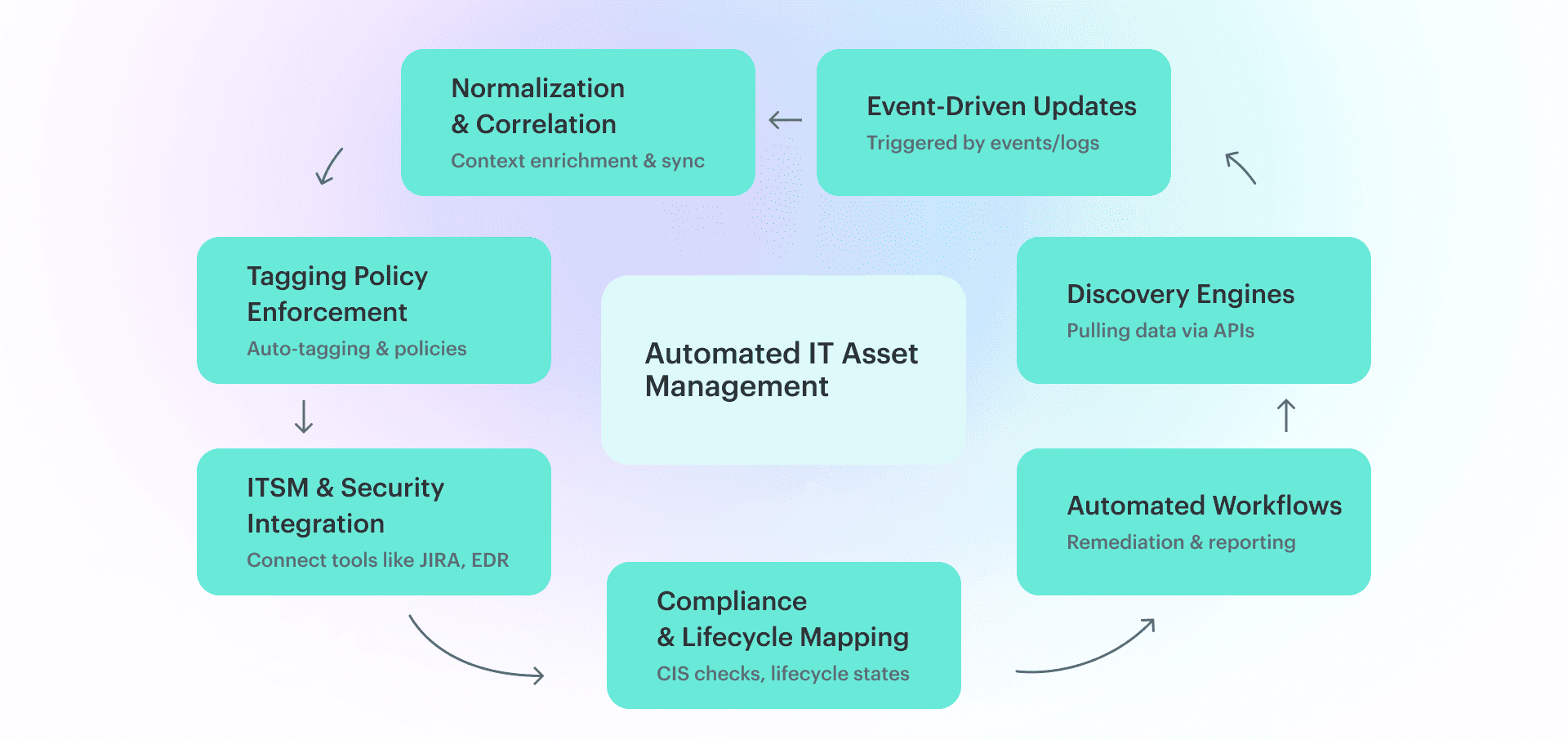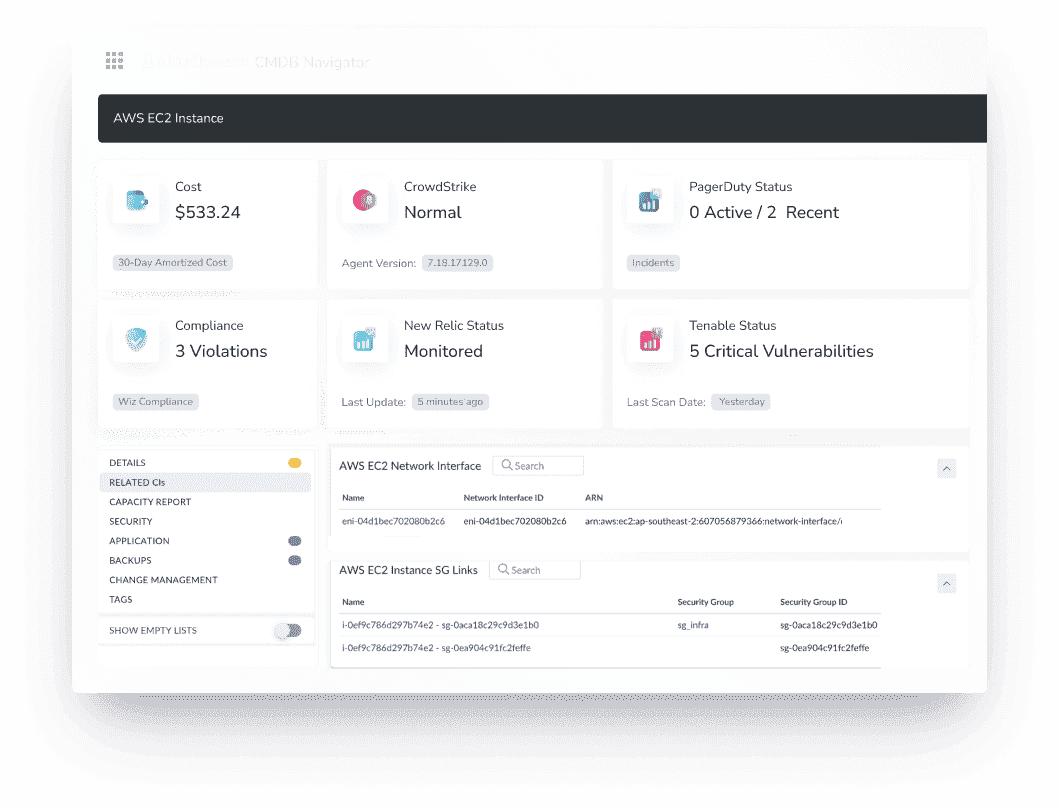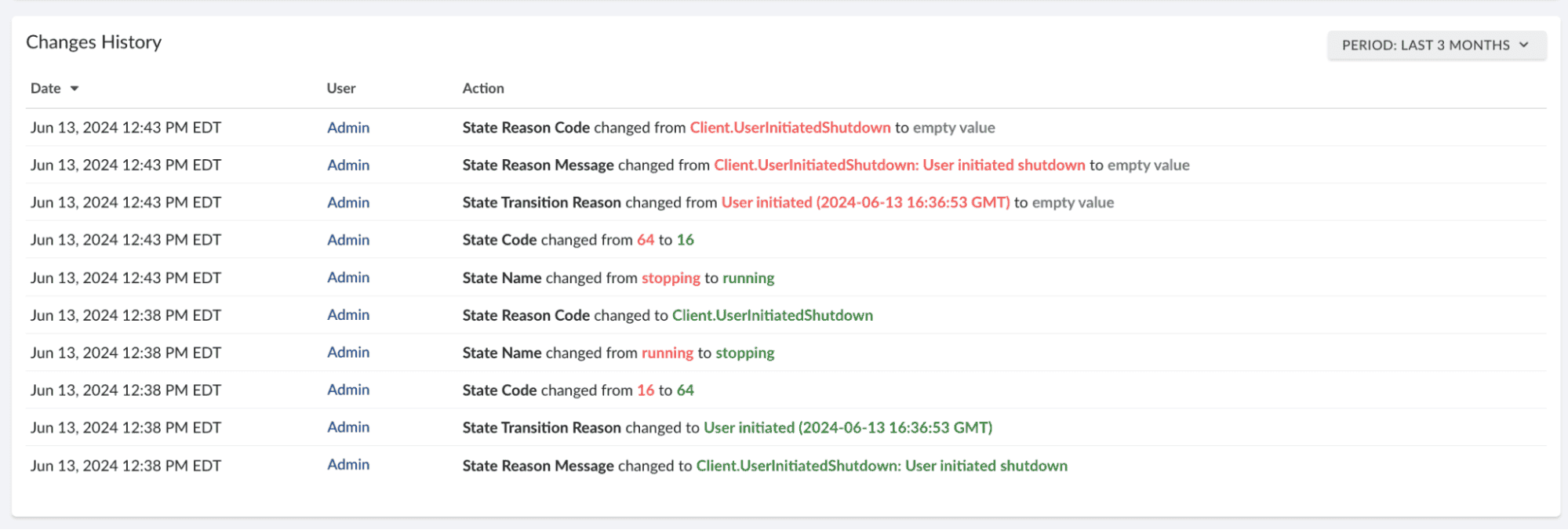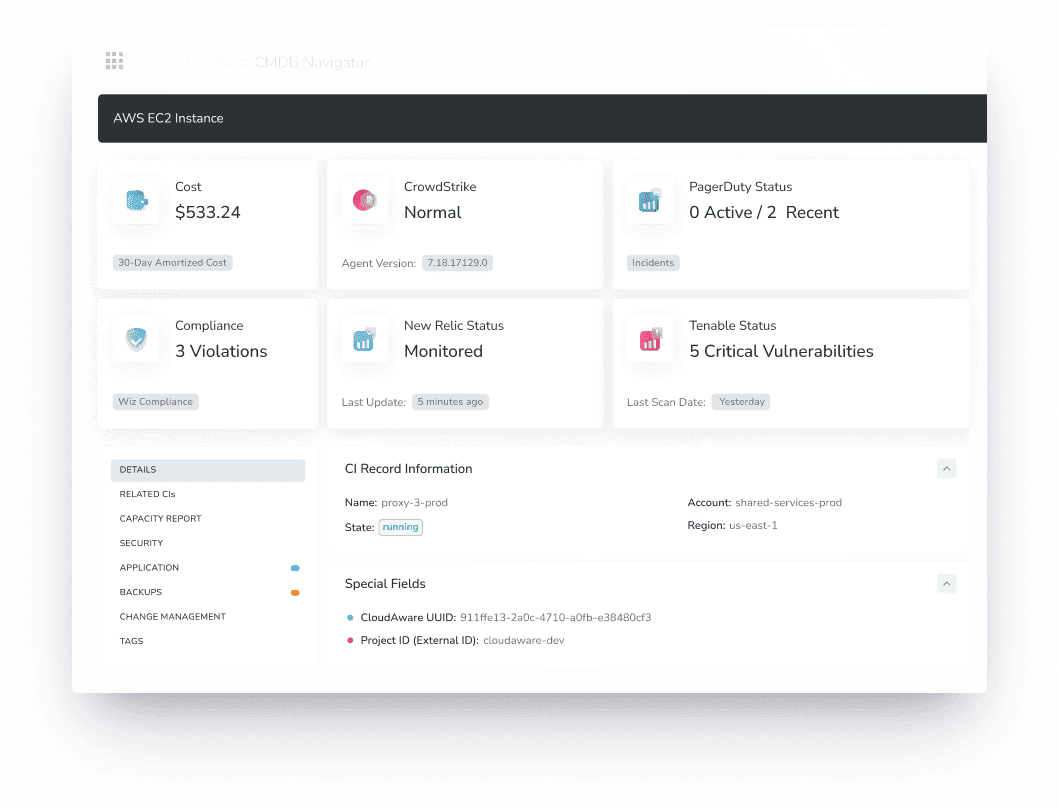If you’ve ever stared down a spreadsheet full of half-tagged assets with names like dev-test-final-v2-backup-old, you’re not alone. You’ve probably wondered who created them — and why they still exist. Manual asset management wasn’t built for ephemeral workloads, IaC pipelines, or the 40 shadow projects that never got offboarded.
We’ve outgrown it.
In this guide, I’ll walk you through how we made automated asset management not just possible, but pleasant. We’ll go from reconciling your CMDB with dynamic discovery, to syncing data with CIS benchmarks, and enforcing tagging policies that actually stick. This is the playbook I wish I had when our infra doubled and visibility fell off a cliff.
No fluff. Just workflows, tools, and the hacks that saved our sanity.
Have no time for reading? Discover key insights of this article 👇
- Real-time inventory is a must. Assets are pulled continuously from sources like AWS, Azure, Jamf, and CloudTrail into the CMDB — no more stale exports or guessing what’s running.
- Tagging should be enforced at creation. Tags are applied automatically via IaC (Terraform, CloudFormation, etc.), so teams don’t have to chase compliance — one team hit 95% coverage in a month.
- Compliance is built-in, not bolted on. Automated checks against CIS benchmarks flag misconfigs early and log everything for audits — one fintech cut prep time from 3 weeks to 3 days.
- Cross-team visibility becomes real. Assets are enriched with context like app names, owners, and cost centers — making it easier for Finance, DevOps, and SecOps to work off the same data.
- Incidents come with context. Alerts include ownership and dependency data, so teams can respond faster — one SaaS org cut incident response time by 50%.
Want more? Continue reading 👇
What is automated asset management?
Automated asset management is the engine behind clean, current, and complete visibility across your infra. No more babysitting spreadsheets, manual tagging, or chasing owners in Slack.
At its core, it’s the continuous discovery, normalization, and correlation of every asset across your environments — cloud, on-prem, SaaS, you name it. The data is pulled in automatically, enriched with context, and made actionable.

Here’s the process automation IT asset management👇
You’ve got connectors pulling metadata from your AWS accounts, Azure subscriptions, and GCP projects. They use APIs, EventBridge, and CloudTrail logs to get what they need.
All that data gets funneled into your CMDB, like Cloudaware. There, it’s correlated against sources like AWS Config, Azure Resource Graph, and GCP Asset Inventory. It also ties in with tools like CrowdStrike, Jamf, ServiceNow, and even Jira tickets.
Now imagine this: every asset, normalized by type. EC2s, EKS nodes, and ELBs — mapped with their dependencies, ownership, lifecycle stage, and tags. All auto-validated against your tagging policy and CIS benchmarks — in real time.
You can query your fleet by application, environment, team, even compliance status. Missing encryption on S3? Drifted Terraform resource? Non-compliant public IP in a dev subnet? All flagged, tracked, and added to your live inventory.
Now that we’ve unpacked how it actually works under the hood, let’s deep-dive into what it really brings to the table.
5 things ITAM automation will bring to your business
If your team’s buried under alerts, audits, and untagged assets, it’s probably time to stop managing chaos and start automating it.
This is where the real benefits of IT asset management automation kick in. We're not talking about prettier dashboards — we're talking about less firefighting, faster decisions, and data you can actually trust.
Here are five things you’ll gain when you stop managing assets the old way and start letting automation do the heavy lifting 👇
1. Clean, continuous inventory
You know that pit in your stomach when someone casually asks, “*Can you pull a full asset list by end of day?*”
Yeah. Been there.
With automation running your asset management, that task isn’t a nightmare anymore — it’s a dropdown filter. Real-time data streams in from AWS, Azure, GCP, even Jamf and VMware.
The CMDB stays up to date without you lifting a finger. No exports, no VLOOKUP drama. Just live, trusted inventory.
One of our clients — huge healthcare player — reduced manual inventory checks by 80% in the first month. It’s like finally having a map where every piece of your infra actually shows up.
Read also: Expert Review of Top 10 IT Inventory Management Software For 2025
2. Tagging that actually sticks
You’ve got policies, sure. But when someone spins up an EC2 at 2AM under pressure? Tags go out the window.
Automation steps in where policy alone fails. It wraps around Terraform deploys, CloudFormation templates, even manual clicks in the console — and makes sure IT assets are tagged correctly, flagged if they’re not, and tied back to something meaningful like a team or an environment.
I saw a platform team go from 40% tag coverage to over 95% in a month. No blame. No chasing. Just tags that work.
3. Real-time compliance & audit readiness
Audits don’t wait. And they don’t care that your CMDB hasn’t synced since Tuesday.
A quarter of respondents have paid more than $5 million in audit costs over the past three years, up from 15% in 2023.
Automation aligns your infra with CIS benchmarks, so things like public access, encryption, backup status, and unapproved regions are surfaced before they hit the risk register.
We helped a fintech client — super regulated — cut audit prep time from three weeks to just three days. Because everything was already mapped, validated, and sitting in the CMDB. You’re not playing catch-up. You’re walking into audits with receipts.
4. Cross-team visibility that actually helps
Ever had your SecOps team flag something critical… but no one knows who owns it? Or watched Finance guess at what project owns which resources?
Automated ITAM brings structure to that chaos. Assets aren’t just listed — they’re linked to business context: apps, owners, cost centers, environments.
So instead of throwing tickets into the void, teams collaborate faster. I watched a DevOps org use this setup to build internal dashboards where product leads could self-serve infra data — without pinging ops every 20 minutes. Huge win.
5. Faster incident response with actual context
You know those alerts that hit PagerDuty at 2AM and just say “resource not compliant”?
Useless.
What you need is context: what’s the asset, what’s it connected to, who touched it last, and is it even supposed to exist? Automation gives you that. You don’t dig — you just know.
In one SaaS team I worked with, incident response time dropped by nearly 50% once asset relationships were mapped and live. When your CMDB works with you, every minute counts less… because you need fewer of them.
Read also: Everything you should know about IT hardware asset management in 2025
7 steps to automate of your IT assets management
Here’s how to actually automate asset tracking in a hybrid, multi-cloud environment — step by step. This guide below includes all tech that works and workflows that won’t collapse the next time someone spins up a new account on a Friday afternoon.
1️⃣ Set your goals (more than just “visibility”)
Before connecting a single API, define what you actually want from automated asset management. Your goals should sound like ops reality — not buzzword bingo.
Ask yourself:
- Can I identify every cloud asset that’s missing encryption?
- Do I know who owns what, and when it was last changed?
- Can I trust my inventory when an auditor walks in tomorrow?
- Is it easy to spot assets that violate our tagging or CIS-based config rules?
This step keeps your future self sane. It turns your automation project into a real-time operational backbone — not just another dashboard collecting dust.
2️⃣ Automate the data pull with source integrations
This is where automated asset tracking begins. Start pulling metadata using native APIs:
- AWS: Config, CloudTrail, EC2 Describe, Resource Groups Tagging API
- Azure: Resource Graph, Defender, Policy Insights
- GCP: Cloud Asset Inventory, SCC, Logging
- On-prem: VMware vSphere, Jamf, EDR tools like CrowdStrike
Set ingestion on a timer — or better yet, event-driven triggers. That means real-time updates when something changes. When someone adds a public IP to a prod subnet, you’ll know in time to do something about it.
💡 Pro tip: Blend in data from CI/CD, Git, and ticketing systems for deeper context.
3️⃣ Normalize, enrich, and build your inventory
Now that you’ve got raw data coming in, turn it into something usable.
Group and normalize resources by type:
- EC2 → Compute
- ALB → Load Balancer
- GKE Node → Kubernetes Host
- RDS → Database
Then enrich with what your management team actually needs to see:
- Owner, application, cost center
- Lifecycle status (active, deprecated, orphaned)
- Backup status, encryption config, last patch time
Here is an example of a CI enriched with related items, cost and vulnerabilities data in Cloudaware CMDB:

To know how it works, schedule a demo with ITAM experts.
This isn’t just a list — it’s your live asset inventory, and it should answer questions before someone even asks them.
4️⃣ Tagging and ownership enforcement — automatically
Here’s where so many teams break down: tagging.
Automate enforcement at the asset creation layer. Use:
- Terraform policies
- CloudFormation hooks
- Azure Policies or AWS SCPs
- Git pre-commit validators for IaC
Every new asset must come with required tags: Owner, Environment, Application, and CostCenter. If not? Flagged and routed for action.
We had one team go from 47% tagging coverage to 96% in a sprint and a half — just by automating these checks at the source.
5️⃣ Tie in change and ticketing systems
Pull data from ServiceNow, Jira, and deployment pipelines. This makes your asset data alive — you can track changes over time, link them to the right incident or request, and avoid “I have no idea who did this” detective work.
Example of the IT asset change history report in Cloudaware:

To know how it works, schedule a demo with ITAM experts.
Assets aren’t just objects — they’re stories. And automation makes those stories visible.
6️⃣ Map assets to policy and compliance frameworks
Use CIS benchmarks, NIST mappings, or your internal config standards. Tie those to specific asset fields:
EncryptedAtRest: false→ CIS violationPublicAccessible: trueon a prod DB → Red flagBackupStatus: missing→ SLA breach
Make compliance not just a report, but something that lives inside your IT asset management system.
7️⃣ Actionable views + response loops
Build filtered, role-based views:
- SecOps sees risky or noncompliant assets
- Engineering sees drifted or shadow infra
- Management sees inventory trends, tag coverage, and ownership status
And make the system respond. Tickets. Slack alerts. Lifecycle field updates. Do it in time, before small issues turn into production outages.
This isn’t just “asset visibility.” This is automated asset management that earns its keep. It keeps your inventory real, your audit trail tight, and your environment ready for whatever surprise the cloud throws at you next.
Read also: IT Asset Management Audit For Hybrid Setup: 9-Steps Checklist
3 automation lifehacks from Cloudaware ITAM experts
So how do you actually do automated asset management when you’ve got clouds, clusters, and chaos flying in every direction? I’ve asked a few battle-tested ITAM pros from my team who’ve been through the fire.
Here’s what they had to say — no fluff, just the kind of advice you wish someone had handed you before that last audit.
Build your inventory like it’s your control plane
Iurii Khokhriakov, Technical Account Manager:
“I’ve been in shops where the asset management strategy was basically “hope the CMDB sync ran last week.” It doesn’t work. Real automation starts with reliable, multi-source discovery. You need a system that pulls from every angle — cloud APIs, logs, EDR platforms — and enriches on the fly.
When you plug that data into a normalized structure aligned with CIS benchmarks, things click. You stop firefighting. You start seeing. And that’s when you actually get control back. I’m not talking about shiny dashboards — I’m talking about inventory that tells the truth right now.”
Tag it at the source or fix It forever
Kristina S., Senior Technical Account Manager at Cloudaware:
“You want clean infra? Tag it before it lives. Automate it at the asset creation point — Terraform, CloudFormation, I don’t care. Just don’t wait until after deploy. I’ve built pipelines that fail builds if Environment, Owner, and CostCenter tags aren’t there.
SCPs in AWS? Mandatory.
Console deploys? Blocked without required keys.
It’s not about making people follow policy. It’s about making policy enforce itself.
Once we did that, our tagging went from chaos to 98% coverage in less than a month — and we stopped getting mystery resources in billing reports. Total game-changer.”
If your assets can’t talk, you’re flying blind
Mikhail Malamud, Cloudaware GM:
“Your inventory needs to include relationships, ownership, lifecycle stage, even ticket history — otherwise, you’re just staring at lists. I’ve worked with teams who mapped every management field to CIS/NIST controls and built smart alerts on top.
The result? Assets weren’t just visible — they were accountable. We cut MTTR by half. We stopped asking, “who owns this?” because the system told us. When your CMDB thinks like your team does, it stops being overhead and starts being leverage.”
Read also: Master IT Inventory Management in 2025. Expert Hacks & Tools
Level up ITAM with Cloudaware CMDB
Forget about scheduled imports and dusty integrations.
Cloudaware CMDB helps you automate discovery, tracking, and enrichment across your environment. It integrates instantly with your stack and gives you full control over every step. Get real-time visibility into your asset inventory — no manual schedules. Each automated asset is enriched with ownership, cost, vulnerabilities, patch data, and compliance status.

You’ll get alerts on everything — change events, config drift, compliance violations, and open vulnerabilities. But nothing is auto-remediated without your say-so. It’s management, not magic.
What you get:
- Real-time asset management via native cloud APIs & event logs
- Instant integration with AWS, Azure, Google Cloud, Oracle, on-prem, and even Alibaba.
- Automated asset enrichment with tagging, security, and compliance context
- Live asset inventory with change tracking and lifecycle insights
- Smart alerts across every part of the CMDB workflow
- Workflow automation + human approvals for true asset governance
